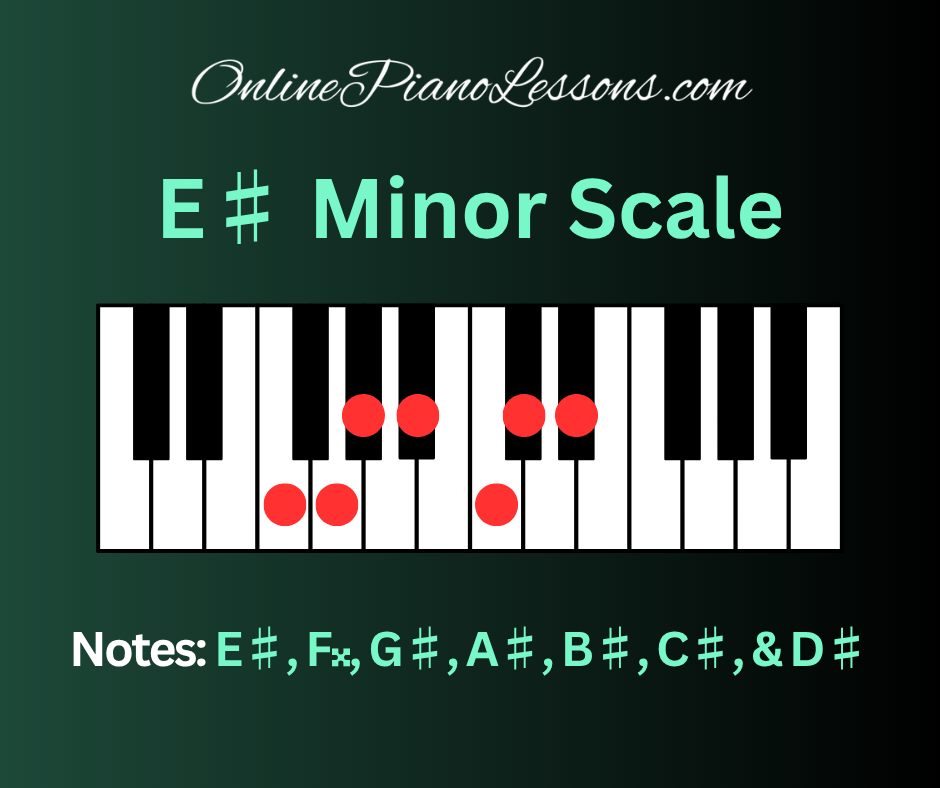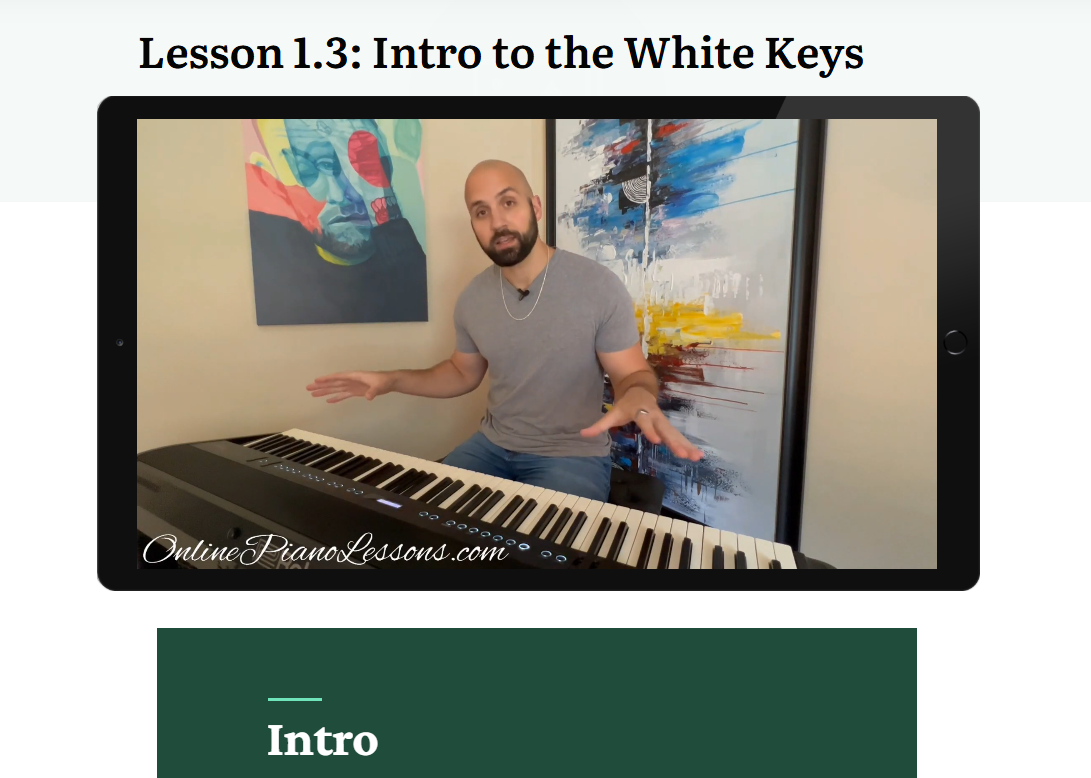
The E sharp minor scale is an extremely rare and highly theoretical key—but it’s also fascinating. On paper the E# minor scale exists and can be spelled precisely, but in practical piano playing most pianists treat it as the enharmonic equivalent of F minor. This guide explains what the E sharp minor scale is, how to find and spell it, how it sounds on the piano, practical fingerings and exercises (using its enharmonic F-minor form for ease), and musical uses of the E# minor scale. Throughout the guide I’ll use both names—E sharp minor scale and E# minor scale—so you get a clear picture of both the theoretical and the playable sides.
What Is The E Sharp Minor Scale?
When we say “E sharp,” we mean the pitch one semitone above E natural. On a tempered piano that pitch sounds the same as F natural, but notationally E# is spelled and treated differently. The E sharp minor scale (E# minor scale) is simply the minor scale whose tonic is E#. In strict theoretical notation the natural E# minor scale is spelled with many sharps and even double-sharps.
Because the E# minor scale is enharmonically identical to the F minor scale (they sound the same on the piano), most composers and editors prefer to write F minor rather than E# minor. Even so, the E# minor scale is useful in theoretical contexts (for example, when a passage modulates from sharp-heavy keys and the notation must preserve consistent letter names).
Spelling The E Sharp Minor Scale (Theoretical Notation)
If you want the exact theoretical spelling, the natural E# minor scale is written as:
E# – F## – G# – A# – B# – C# – D# – E#
Why so many sharps? Because each scale degree must have a distinct letter name (E, F, G, A, B, C, D) and minors raise or lower certain degrees relative to the major scale. To convert the more familiar F minor notes into E#-based spellings, you end up with F## (which sounds like G), B# (which sounds like C), and even, in harmonic or melodic forms, double-sharps such as D## (which sounds like E). For reference:
- Natural E# minor: E# – F## – G# – A# – B# – C# – D# – E#
- Harmonic E# minor (raised 7th): E# – F## – G# – A# – B# – C# – D## – E#
- Melodic E# minor (ascending; raised 6th & 7th): E# – F## – G# – A# – B# – C## – D## – E#
(descending melodic usually reverts to the natural form)
These spellings are correct theoretically but visually intimidating. On the piano, however, the E# minor scale produces exactly the same pitches as F minor.
Why Pianists Prefer F Minor (The Practical Side)
For practical piano playing, the E# minor scale is nearly always treated as F minor. The F minor scale is far easier to read and has the following notes:
F – G – A♭ – B♭ – C – D♭ – E♭ – F
F minor uses four flats in its key signature and is common in repertoire. When a score conceptually lies in an E# tonal area but is easier to read as F minor, editors and composers almost always use F minor notation. So if your aim is to practice the E# minor scale on the piano, do the scale, arpeggios, and progressions in F minor—your fingers and ear will be training on the exact pitches.
How The E# Minor Scale Sounds On Piano
Because the E# minor scale is enharmonic to F minor, its sonic character is that of a warm, somewhat dark minor key. F minor (and therefore the E# minor scale) often conveys drama, introspection, or tragic lyricism in Western music. On piano, the lowered third and sixth create a melancholic color. When composers use raised sixths or sevenths (the melodic or harmonic variants), the scale can acquire a more yearning or classical tension that wants to resolve to the tonic.
If you play the E# minor scale on the piano as F minor, you’ll hear that same expressive quality: minor, rich, and versatile across genres.
Fingerings And Practical Exercises (Use F Minor On The Piano)
Because the notated E# minor scale is cumbersome, here’s a practical set of fingerings and exercises using F minor (the enharmonic equivalent) that accomplish the exact same piano training you’d get from E# minor.
F Minor Two-Octave Scale (Right Hand Ascending):
1 (F) – 2 (G) – 3 (A♭) – 1 (B♭) – 2 (C) – 3 (D♭) – 4 (E♭) – 5 (F)
F Minor Two-Octave Scale (Left Hand Ascending):
5 (F) – 4 (G) – 3 (A♭) – 2 (B♭) – 1 (C) – 3 (D♭) – 2 (E♭) – 1 (F)
Practice these slowly with a metronome, hands separate then together. The exercises below will build fluency in the pitches of the E# minor scale while keeping the notation practical.
Arpeggio (F Minor):
F – A♭ – C – F (root position); practice inversions and two-octave patterns.
Harmonic Drill:
Practice the harmonic minor variant by raising the seventh (E♭ → E♮) in ascending practice if you want to simulate harmonic E# minor behavior (that would mean playing D## in the spelled E# context—but on the piano you’ll play E natural).
Melodic Drill:
Practice ascending melodic minor (raise the sixth and seventh) and descending natural minor. On the piano in F minor this means ascending use D♮ and E♮ and descending revert to D♭ and E♭.
Using F minor fingerings gives you all the ear and hand benefits of practicing the E# minor scale on the piano without the notational gymnastics.
Diatonic Chords (E# Minor Spelled vs. F Minor Practical)
If we spell the chords in E# minor theoretically they look complex (e.g., E# minor = E#–G#–B#), but their sounding equivalents are simple F-minor chords. Here’s the practical (F minor) chord set every pianist should know—which represents the sonic content of the E# minor scale:
- i: Fm (F – A♭ – C) — enharmonic to E# minor triad.
- ii°: Gdim (G – B♭ – D♭) — enharmonic to F##? spelled equivalents.
- III: A♭ (A♭ – C – E♭) — enharmonic of spelled G# chord in E# notation.
- iv: B♭m (B♭ – D♭ – F)
- v (or V when raised): C (or C7) — raising the third creates a stronger dominant (C → C major with E natural corresponds to spelled C𝄪 in E# theory).
- VI: D♭ (D♭ – F – A♭)
- VII: E♭ (E♭ – G – B♭)
Common progressions that sound like E# minor on the piano include i – VI – III – VII (F m – D♭ – A♭ – E♭) or i – iv – V (F m – B♭m – C or C7).
Repertoire And Uses
True E# minor notation is rare, so you won’t see many pieces written explicitly in an E sharp minor scale. However, any repertoire in F minor demonstrates the musical character you’d expect from E# minor: romantic piano works, film music passages, and expressive harmonic minor cadences. If you encounter E# notation (for instance, in advanced chromatic music or theoretical exercises), treat it as F minor sonically and rely on enharmonic reading practices.
When E# Minor Notation Might Appear
You may come across the E# minor scale in these situations:
- Advanced theoretical examples where letter names must remain consistent across a modulation from sharp keys.
- Highly chromatic scores where enharmonic respelling preserves voice-leading clarity.
- Analytical textbooks showing how a passage relates to a sharpened scale degree rather than simply switching to flat notation.
Even in such cases, pianists frequently simplify by thinking “this is F minor in sound” and play accordingly.
FAQ
Is the E# minor scale the same as F minor?
Sonically yes—E# minor scale is enharmonically identical to F minor. On the piano the pitches are the same. Notationally they differ: E# minor uses sharps and sometimes double-sharps.
Why would anyone write E# rather than F?
Notation choices reflect theoretical relationships. When music moves through keys where letter consistency matters, composers may spell a passage using E# to preserve correct scale-degree naming.
What are the notes of the E# minor scale in theory?
The natural E# minor scale is spelled E# – F## – G# – A# – B# – C# – D# – E#. The harmonic and melodic variants introduce double-sharps (e.g., D##) for raised degrees.
How should I practice the E# minor scale on the piano?
Practice it as F minor (F – G – A♭ – B♭ – C – D♭ – E♭ – F). Use standard minor scale fingerings, arpeggios, harmonic and melodic variants (raising appropriate scale degrees on the piano).
Are there famous pieces in E# minor?
Not commonly. Most repertoire in this sonic area is published in F minor. If you see E# minor in an analytical example, play it as F minor on the piano.
Does practicing the E# minor scale help my technique?
Absolutely. Working through the E# minor scale as F minor strengthens hand shapes, black-key familiarity, and minor-mode fluency—valuable for pianists.





 Hi, I'm Thomas, Pianist Composer,
Hi, I'm Thomas, Pianist Composer,  I love playing piano, creating new melodies and songs, and further developing my online piano course and making updates/additions to my site OnlinePianoLessons.com!
I love playing piano, creating new melodies and songs, and further developing my online piano course and making updates/additions to my site OnlinePianoLessons.com!  Now that is what I call fun!
Now that is what I call fun!





